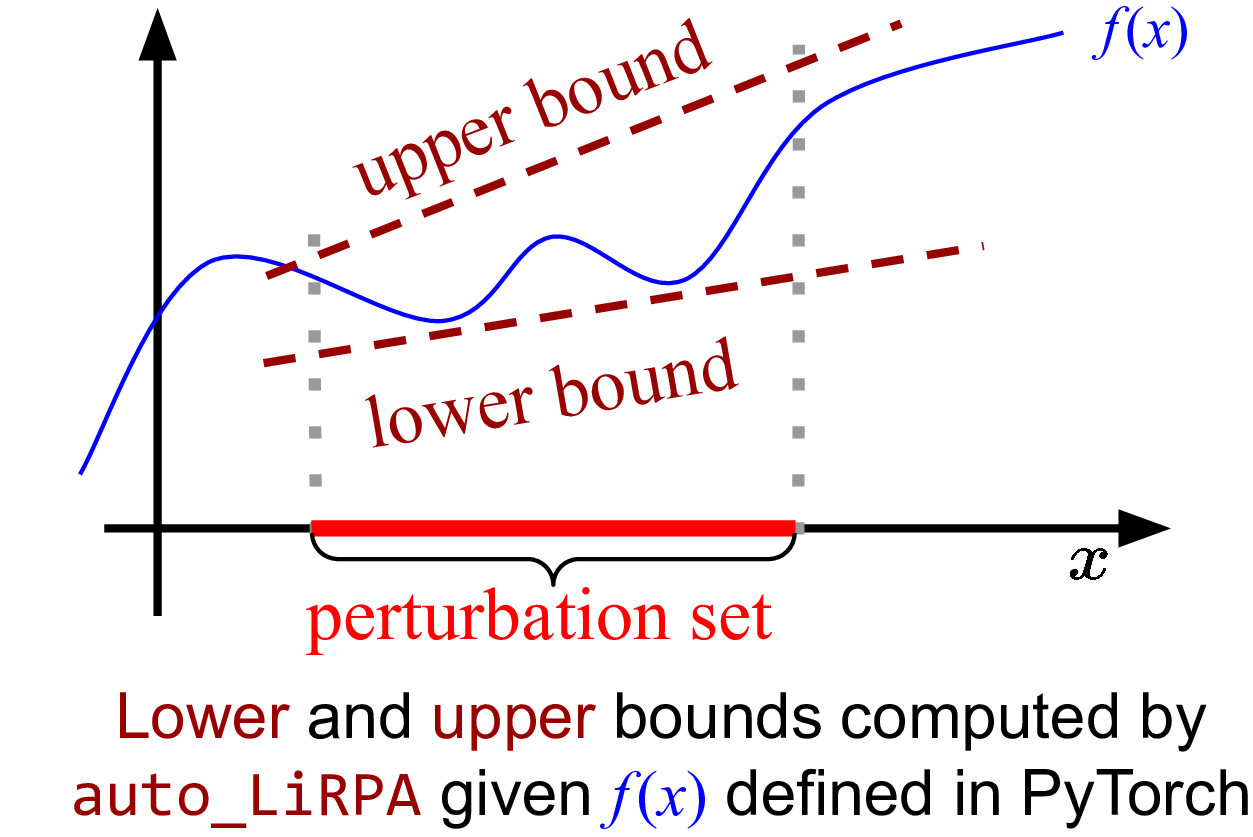What is auto_LiRPA? auto_LiRPA is a library for automatically deriving
and computing bounds with linear relaxation based perturbation analysis (LiRPA)
(e.g. CROWN and
DeepPoly) for
neural networks. LiRPA algorithms can provide guaranteed upper and lower
bounds for a neural network function with perturbed inputs. These bounds are
represented as linear functions with respect to the variable under
perturbation. LiRPA has become an important tool in robustness verification and
certified adversarial defense, and we believe that it can become an useful tool
for many other tasks as well.
Our algorithm generalizes existing LiRPA algorithms for feed-forward neural networks to a graph algorithm on general computational graphs. We can compute LiRPA bounds on a computational graph defined by PyTorch, without manual derivation. Our implementation is also automatically differentiable, allowing optimizing network parameters to reshape the bounds into certain specifications.
Why we need auto_LiRPA? The aim of this library is to facilitate the
application of efficient linear relaxation based perturbation analysis (LiRPA).
Existing works have extended LiRPA from feed-forward networks to a few more
network structures like ResNet, RNN and Transformer, however they require
manual derivation and implementation of the bounds for each new type of
network. Our framework allows automatic bound derivation and computation for
general computational graphs, in a similar manner that gradients are obtained
in modern deep learning frameworks -- users only define the computation in
forward pass, and auto_LiRPA traverses through the computational graph and
derives bounds for any nodes on the graph. With auto_LiRPA we free users
from deriving and implementing LiPRA for most common tasks, and they can simply
apply LiPRA as a tool for their own applications. This is especially useful
for users who are not experts of LiRPA and cannot derive these bounds manually
(LiRPA is significantly more complicated than backpropagation).
How to use it? We provide a wide range of examples of using auto_LiRPA.
See More Examples below. If you have an example based on
auto_LiRPA that can be potentially helpful for other users, you are
encouraged to create a pull request so that we can include your example here.
Any contributions from the community will be greatly appreciated.
The main algorithm of auto_LiRPA is discussed in our
paper. We demonstrated several complicated
applications including certified training with non-Lp norm perturbations
(synonym perturbations) on Transformer, and training a neural network with
better flatness (less sensitive to weight perturbations). Please refer to the
guidance for reproducing paper results for details, and cite
our paper if you find auto_LiRPA useful:
Automatic Perturbation Analysis on General Computational Graphs. Kaidi Xu*, Zhouxing Shi*, Huan Zhang*, Minlie Huang, Kai-Wei Chang, Bhavya Kailkhura, Xue Lin, Cho-Jui Hsieh (* equal contribution). https://arxiv.org/pdf/2002.12920
This repository is mainly maintained by Kaidi Xu (xu.kaid@husky.neu.edu) and Zhouxing Shi (zhouxingshichn@gmail.com). Feel free to contact us or open an issue if you have problems when using our library.
Before you run any examples, please install auto_LiRPA first:
git clone https://github.com/KaidiXu/auto_LiRPA
cd auto_LiRPA
python setup.py install
Note that this library is still under heavy development. We are still working
on implementing more primitive operations on computational graphs. These
operations are implemented in auto_LiRPA/bound_ops.py. For example, if you
add a custom activation function that is not supported by our framework, you
can implement it in this file.
If you encounter any problems with this library, feel free create an issue or pull request. We welcome contributions in any form from anyone.
First define your computation as a nn.Module and wrap it using
auto_LiRPA.BoundGeneral(). Then, you can call the compute_bounds function
to obtain certified lower and upper bounds under perturbation:
# Define computation as a nn.Module
class MyModel(nn.Module):
def forward(self, x):
# Define your computation here
model = MyModel()
my_input = load_a_batch_of_data()
# Wrap model with auto_LiRPA
model = auto_LiRPA.BoundGeneral(model, my_input)
# Define perturbation
ptb = PerturbationLpNorm(norm=np.inf, eps=0.1)
# Compute LiRPA bounds
lb, ub = model.compute_bounds(ptb=ptb, x=my_input, method="backward")Checkout examples/vision/simple_verification.py for a complete but very basic example.
We provide many examples of using our auto_LiRPA library,
including robustness verification and certified robust training for fairly
complicated networks and specifications.
We provide a very simple tutorial for auto_LiRPA at
examples/vision/simple_verification.py.
This script is self-contained. It loads a simple CNN model and compute the
guaranteed lower and upper bounds using LiRPA for each output neuron under a L
infinity perturbation.
python -m examples.vision.simple_verificationWe provide a simple example of certified training. By default it uses CROWN-IBP to train a certifiably robust model:
cd examples/vision
python simple_training.pyThe default model is a small model, and you can get around 10%-11% verified error (at Linf eps=0.3) after training.
In examples/sequence, we have an example of training a certifiably robust LSTM on MNIST, where an input image is perturbed within an Lp-ball and sliced to several pieces each regarded as an input frame. To run the example:
python -m examples.sequence.trainIn examples/language, we show that our framework can support perturbation specification of word substitution, beyond Lp-ball perturbation. We perform certified training for Transformer and LSTM on a sentiment classification task.
To train a robust Transformer:
python -m examples.language.train --model=transformer --robust --ibp --method=backward --trainAnd to train a robust LSTM:
python -m examples.language.train --model=lstm --grad_clip=5.0 --lr=0.001 --robust --ibp --method=backward --trainWe provide an example for training a robust network under weight perturbations by applying LiRPA bounds on network weights rather than inputs. This essentially obtains a network that has "flat" optimization landscape (a small change in weight parameters do not change loss too much).
cd examples/vision
python train_general.py --config config/mnist_crown_L2.json --path_prefix saved_models --model_subset 2See more details in doc/paper.md for this example.
